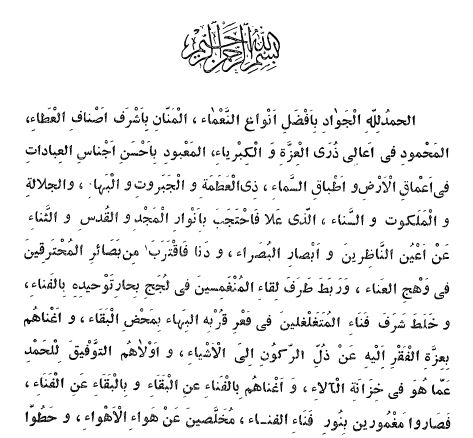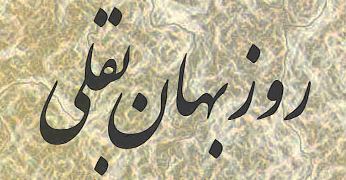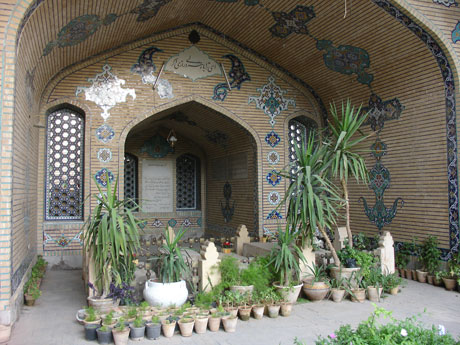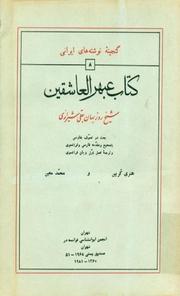
The word Baha' in Persian poetry and related Arabic Literatures
Stephen Lambden UCMerced.
In progress 1980s-2017.
The Persianate poets and their uses of the word baha', for Baha'is the Greatest or Mightiest Name of God.
Radí al-Dín ibn Tawús (1193-1266 CE).
Echoing the Shi`i Ramadan Dawn Prayer or Du`a al-Bahā' is the following spontaneous supererogatory supplication for the month of Ramaḍan transmitted by Abī `Abd Allāh (Imām Ja`far al-Ṣādiq, d. c. 80/669-700) cited in Majlisī's Biḥār al-anwār from the devotional text, Iqbāl al-aʻmāl of Sayyid Raḍi al-Dīn, ʻAlī ibn Mūsá Ibn Ṭāwūs (589/1193-664/1266) :
"O my God! I verily, ask Thee by Thy Name which is inscribed in the pavilion of (surādiq al-majd) and I beseech Thee by Thy Name which is inscribed in the pavilion of Splendour (surādiq al-bahā'). I verily, ask Thee by Thy Name which is inscribed in the pavilion of Grandeur (surādiq al-`aẓamat) and I beseech Thee by Thy Name which is inscribed in the pavilion of radiance (surādiq al-jalāl). I verily, ask Thee by Thy Name which is inscribed in the pavilion of Might (surādiq al-`izzat) and I beseech Thee by Thy Name which is inscribed in the pavilion of Secrets (surādiq al-sarā'ir) which is Foremost (al-s_b_q), Paramount (al-f_'iq), Beauteous (al-husn), and Splendid (al-na_r). And by the Lord of the Eight [Arch-] Angels (al-malā'ikat al-thamāniyat) and the Lord of the Mighty Celestial Throne (rabb al-`arsh al-`aẓīm)." (Cited Majlisī, Biḥār2 58:43).
See ʻAlī ibn Mūsá Ibn Ṭāwūs
- Iqbāl al-aʻmāl ed. Ḥusayn al-Aʻlam. Beirut: Muʼassasat al-Aʻlamī lil-Maṭbūʻāt, 1996. 872 pages.
The Lifeblood of the Supplications.. (Muhaj al-da`wát..) is a compilation of prayers attributed to the Prophet Muhammad and the Twelver Imáms compiled by Raí al-Dín ibn Tawús (1193-1266 CE). Within it is an Arabic prayer attributed to the Prophet Muhammad which came to be entitled Du`a al-hujub ("The Supplication of the Veils"). [18] It contains the following line which associates the word bahá' with the Sinaitic theophany [19]:
"I beseech Thee [God] by the Names (al-asmá') through which Thou didst manifest Thy glory (tajalli) before the Speaker [al-kalím, Moses] upon the mighty mountain [Sinai]. When sunbeams of the light of the Veils [of Light hiding the Divinity] were manifested from the bahá' ("splendour") of the Divine Grandeur (al-`azimat) such that the mountain was levelled.." (cf. Qur'án 7:143). [20]
Bahá'u'lláh, it will be recalled, mystically identified himself with the Divine Being Who conversed with Moses on the Sinai of inner realization. Relative to Bábí-Bahá'í scripture the use of the word bahá' ("splendour/glory") here for the divine theophany upon Sinai, is prophetically significant (see below). It is of interest that in one of his writings the Báb identified the "Greatest Name" with the Divine Reality which appeared to Moses on Sinai (INBA. MS 6003C 173-188). Indeed, in his Qayyúmu'l-asmá súra 77 he also reckoned the vehicle of this Divine manifestation the "Light of Bahá'" (cf. below).
`ATTAR
Abū Ḥamīd bin Abū Bakr Ibrāhīm ibn Ishaq (b. Nishapur c. 1145 – d. Nishapur. c. 1221), Farid al-Din `Attar (d. 1239)

In the Arabic theological preface or introduction to his famous prose work, the Tadhkirat al-awliya' (Memorials of the Chosen One-Sufi Saints'), Farid al-Din `Attar (d. 1239), makes interesting use of the word al-baha'. This Persian prose Tadhkirat al-awliya' (Memorials of the Saints) has a highly-theological two page Arabic prolegomenon of testimony to God and his Prophet Muhammad. In this opening the word baha' is used twice in interesting theological and Sufi type contexts. It has been well-stated that the "Memorial of Gods Friends [tadhkirat al-awliya'] is not primarily a historical recreation of a lost past, but rather an act of sacred remembrance and devotion that intends to enable its readers to transcend the limitations of the self and reconnect with ultimate values and realities" (Losensky, 2009: 3). It contains seventy-two loosely chronologically organized biographical, often hagiographical sketches commencing with the sixth Imam Ja`far al-Ṣādiq (d. c.148/765) until the God-intoxicated Husayn ibn Mansur al-Hallaj (b. al-Bayda' / Ṭūs, Persia, c. 244/858 – d. Baghdad, 309/ 922). It opens as follows:

From the Arabic prolegomenon in the Zavvar edition (page 3f. with pointing by Esti`lami) based on early mss., including one dated 692 /1292-3 (cf. C.A. Storey, Persian Literature: A Biobibliographic Survey (London: Luzac, 1927-) vol. 1, Pt. 2, pp.930-33).
In the Name of God, the Merciful, the Compassionate.
Praised be to God!
One generous on account of the Divine Bounty ... One characteized by Powerful Magnanimity (`azimat), Omnipotence (al-jabarut), and al-baha' (Glory-Splendor-Beauty)
(Lambden Trans. 2017 ; see also the 2009 Losensky translation, p.39f)
- Tadhkirat al-awliya' ed. Muhammad Esti`lami. Tehran: Zavvar, 1346 Sh./1968.
- Arabic Progegomenon PDf. Ar-Preface `Attar Tadhkirat.pdf
- Trans.Paul Losensky, Farid-ad-Din `Attar's Memorial of God's Friends, Lives and Sayings of Sufis (in `The Classics of Western Spirituality' series). New York -Mahwah : Paulist Press, 2009.
♦


The Name in Arabic-Persian script and the 1967 built, Shiraz located tomb of Ruzbihan Baqli (photo Carolyn McIntyre).
Rūzbihān ibn Abī al-Naṣr Baqlī Shirazi (born Pasa, 522/ 1128- d. and buried Shiraz 606/1209).
The writings of Rūzbihān Baqlī Shirazi are especially fascinating for the Baha'i reader. This learned visionary poet was born in Fasā (pop. 2006 = 188,189), in the Sistan and Baluchestan Province, XX miles away from Shiraz where he lived for many years. Shiraz is the same place in southern (SW) Persia where the Babi-Baha'i religions had their genesis. This on the evening (2 hrs and 11 minutes after sunset) of the prophetic declaration of the Bab on May 22nd 1844 or in 1260 of the lunar, Hijri calendar (AH). Being born in 522/1128, Rūzbihān lived over 600 years before the times of the Bab (born in Shiraz in 1819 where he spent the first twenty-eight years of his life - he died in Tabriz) and Baha'-Allah (b. Tehran 1817) who founded and created the Baha'i relgion between 1852 and his death in Acre, Palestine in1892. The Arabic and Persian works of Rūzbihān encompass a wide range of disciplines, including Qur'an commentary, Sufi poetry and theology, as well as jurisprudence and grammar. Here we shall only sum up a few of Rūzbihān Baqli's uses of the word baha' with some occasional, Baha'i oriented, theological observations.
Baha' and baha'-Allah in the Kashf al-asrar (The Unveiling of Secrets) of Rūzbihān Baqlī.
The word baha' and the genitive phrase baha'-Allah occur in number of times in the quasi-autobiographical Arabic Kashf al-asrar (The Unveiling of Secrets) of Rūzbihān Baqlī, the text of which was first published in a modern critical edition by Firoozeh Papan-Matin in collaboration with Michael Fishbein (Leiden-Boston: Brill, 2006). This diary contains glimpses of Rūzbihan's intimate visions of the divine theophany as well as certain of his mystical encounters with angelic beings, prophet figures and Sufi saints.


[Kashf Para 71] I visioned in the middle of the latter night after my prostration upon the carpet of servitude (bisat al-`ubudiyya) in connection with the search for the theophany of the brides of the unseen (zuhur `ara'is al-ghayb), at the very moment when my deepest interior being (sirri) soared up in the climes of the kingdom on high (aqtar al-malakut). I thus visioned the Powerful Majesty of the True One [God] (jalal al-haqq) with the station [on the level] of being enwrapped [clothed] in the form of beauty (maqam al-iltibas `ala hi'at al-husn). This repeatedly (mirar an). Mine inmost heart (fu'ad) was not veiled thereat such that there issued forth from it an unveiling (kashf an) of the Powerful Majesty of an Ever Abiding [Uninterrupted] kind (jalal al-dimuniyya)!
(= Lambden trans. 2017).
In the middle of last night, after sitting on the carpet of devotion in search of the manifestation of hidden brides, when my conscience soared in the regions of the angelic realm, I saw the majesty of God in the station of clothing with divinity, in the shape of loveliness, repeatedly. It did not satisfy my heart, until from it came a revelation of the perpetual majesty that consumes the consciousness and thoughts. I saw a face vaster than all of heaven and earth, and the throne and the footstool, scattering the lights of glory, and it transcended analogies and similitudcs. I saw his glory, 'in the color of the red rose, but it was a world upon world, as if he were scattering red roses, and I saw no limit to it. My [p. 66>] heart remembered the saying of the Prophet, "The red rose is of the glory of Cod." And that was the extent of my heart's comprehension (§71 fn.82 (= Ernst trans., 1996: 66-67).
Carl Ernst introduces the above passage in the following manner under the heading, "F. Theophanies of Beauty" :
The manifestations of divine power, wrath, might, and greatness would be incomplete without the theophanies of divine beauty, and the concomitant qualities of grace, kindness, and generosity. God's beauty appears to Rūzbihan above all in visual forms of lush and intense richness, with showers of roses and pearls providing a suitable side effect. God appears, moreover, in beautiful human forms of prophets like Adam and Joseph, as well as more obscure individuals. Given the predominant anti-anthropomorphic emphasis of Islamic theology, it is at first sight surprising that Ruzbihān can include such visions within the limits of what is acceptable. Rūzbihān takes us to visionary landscapes of endless mountains, deserts, and oceans, to meet angels who embody at once feminine beauty and the warlike qualities of Turkish soldiers. The visual manifestation of Cod in these forms of beauty underlies the continuity between human and divine love. "The red rose is of the glory of God [bahā'-Allāh]"
The rose has been a symbol of great importance in the Persian literary tradition for centuries, so much so that the primordial tale of the nighringale's hopeless love for the rose has been turned into a cliche by countless second-rate poets. l have argued elsewhere that the most powerful source for understanding metaphors like the rose or the bird in this tradition lies in the writings of Sufis like Rūzbihān.81 The experiential directness of the metaphor is still fresh, not yet the hackneyed convention it would later become.
The connection between the divine beauty and the beauty of the rose as an emblem of creation, is unmistakeable. This is couched as a visionary commentary on a Prophetic saying, which in his Qur'an commentary Ruzbihan relates via thee early Sufi al-Wasiti (d. 320/932).83
The many visions of God surrounded by roses, red or hne, underline the celestial significance of the rose. Outpouruings of divine grace are experienced as showers of roses, as we see in his vision of an epiphany in Shiraz"
I saw myself as if I were on the roof of my ribāṭ [hospice, retreat] in Shiraz. I looked up and saw God in our market in the form of majesty and beauty. By God, if the throne saw him in that form, it would melt from the pleasure of his beauty. I entered the oceans of ecstasy, spiritual states, and gladdening visitations weighed with longing, love, and passion. Then I saw myself sitting on me patio of me ribat [hospice, retreat], and God. came in that form with even rnore of his beauty, and wlth him were how many red and white roses! He cast them in front of me, and I was in the station of intimacy and happiness, and the spirit was in a place such that I melted. When me beauties of his attributes and admirable qualities were unveiled to me, men then he hid from me (§ 143).
Carl Ernst comments on the above,
"As a variation on this theophany of beauty, God sometimes appears showering pearls, or even white roses with pearl brocade (§58). Pearls, like roses, have an ancient history as a symbol of divine qualities, in this case a beauty that is rendered more precious by its inaccessibility in shells under the ocean.
"Then I [Rūzbihān] saw above me an atmosphere of white light, from which came showers of white pearls. That is from God's beauty, and he was scattenng them on me. It is beyond expression, nor can intellects comprehend it" (§76).
Prophets like Adam and Muhammad partake of me divine beauty and are themselves dressed in domes of white pearl (§201) (from Ernst, 1996: 67-68).
The Baha'i reader may prefer to view certain of Rūzbihān's bold visions of the personified "rose", in terms of his futuristic visions of the person of the Bab himself - who also applied the word baha' to himself - and/or Mirza Husayn `Ali Nuri, Baha'-Allah (1817-1892). This rather than these vision being a purely personified abstraction, a quasi-heretical, bold, merely anthropomorphically toned expression of "experiential directness". The neo-Babi religion of Baha'-Allah had its roots in Shiraz and his frequently claimed theophanic or divine person took as its greatest name (al-ism al-a`zam) the rose-like word baha' meaning radiant Glory and/ or brilliant Splendour. In this connection one may take note also, of line XX of Baha'-Allah's early, 1852-3 CE., Rashh-i `ama' ("The theophanic sprinking of the theophanic cloud") and of passages within his later 1960s alwah entitled Lawh-i bulbul al-firaq (The Tablet of the Nightingale of Separation) and `The Story of the Nightingale and the Crow' (lawh-i bulbul-i ma`ani va gull').....
The Tafsir, Qur'an Commentary of Rūzbihān ibn Abī al-Naṣr Baqlī Shirazi.
- 'Ara'is al-bayan,
- A. Godlas.

ʻAbhar al-ʾĀshiqīn.
- Le jasmin des fidèles dʻamour [par] Ruzbehan Baqli Shirazi; traité de soufisme en persan publié avec une double introd. et la trad. du chapitre premier. par Henry Corbin et Moh.Moʾin. 1958. 244, 128 p.
Mashrab al-arwāḥ ("The Tavern of Souls")
An interesting occurrence of the word bahā' is to be found in a Prophetic ḥadīth ("tradition") attributed to the propget Muhammad and cited by the outstanding love-mystic and gnostic, Shaykh Rūzbihān Baqlī Shīrāzī (d.1209) in his Mashrab al-arwāḥ ("The Tavern of Souls") and elsewhere ( e.g. Sharḥ-i shaṭṭaḥīyāt) where he reckons the "red rose" a manifestation of God's glory (bahā ') :
"Whenever God wishes to adopt someone as his loving intimate. he shows that person the glory of His Beauty, so that the person falls in love with everything beautiful. The Prophet said,"The red rose is part of God's glory [bahá']. Whoever wishes to contemplate God's glory, let him behold the rose." The gnostic said: "The vision of God's glory occurs at the site of intimacy and expansion." [17]
[17] See Ruzbihan Baqli, Mashrab al-arwah (ed. Nazif M. Hoca Istanbul, 1974) p.262, English trans. Nurbaksh, Sufi Symbolism 4:19.
In her Mystical Dimensions.. Annemarie Schimmel, commenting on this tradition writes, "It was Ruzbihan Baqli who highlighted the prophetic tradition according to which Muhammad declared the red rose to be the manifestation of God's glory ([Bahā'] B 265). He thus gave the rose ‑‑ loved by poets throughout the world ‑‑ the sanction of religious experience; his vision of God is a vision of clouds of roses, the divine presence fulgent as a marvellous red rose. Since this flower reveals divine beauty and glory most perfectly, the nightingale, symbol of the longing soul, is once and forever bound to love it ‑‑ and the numberless roses and nightingales in Persian and Turkish poetry take on, wittingly or unwittingly, this metaphysical connotation of soul-bird and divine rose." (p.299).
Sharh-i Shaṭṭāḥiyyat (Commentary on the Ecstatic Sayings).
- Sharh-i Shaṭṭāḥiyyat (Commentary on the Ecstatic Sayings).ed. Henry Corbin, 1966. 738, 45 p
See Ruzbihan Baqli (ed. and trans. Henri Corbin), Commentaire.. (Sharh-i shaṭṭāḥiyyat), paragraph 265.
♦
Select Bibliography of Rūzbihān Baqlī Shirazi.
ʻAbhar al-ʾĀshiqīn.
Firoozeh Papan-Matin in collab. with Michael Fishbein (ed.).
Rūzbihān Baqlī Šīrāzī, The unveiling of secrets Kashf al-Asrār : the visionary autobiography of Rūzbihān al-Baqlī (1128-1209 A.D.), Islamic history and civilization, vol. 59. Leiden, Boston: Brill, 2006. See below trans. Ernst.
Ghulām ʻAlī Āriyā.
- شرح احوال وآثار ومجموعۀ اشعار بدست آمدۀ شيخ شطاح روزبهان فسايى (بقلى شيرازى)
- Sharḥ-i aḥvāl va āthār va majmūʻah-ʾi ashʻār bi-dast āmadah-i Shaykh Shaṭṭāḥ Rūzbihān Fasāyī (Baqlī Shīrāzī). Tehran: Rūzbihān, 1363/ 1984. 176p.
Risalah al-quds va risalah ghalatat al-salikin.
- Risalah al-quds va risalah ghalatat al-salikin.
Ruspoli, Stéphane
-
Le traité de l'Esprit saint de Rûzbehân de Shîrâz : étude préliminaire, traduction annotée suivies d'un commentaire de son "Lexique du Soufisme". Paris : Cerf, 2001, 362 p.
Ballanfat, Paul.
- Quatre traités inédits de Ruzbehân Baqlî Shîrâzî : textes arabes avec un commentaire. Tehran : Institut français de recherche en Iran, 1998. 226, 224 p. Arabic texts with commentary.
Ernst, Carl W.
- "Ruzbihan Bakli" in Encyclopaedia of Islam (Leiden: E. J. Brill), 2nd ed.: vol, VII: 651-52, 1995.
- Ruzbihan Baqli: Mysticism and the Rhetoric of Sainthood in Persian Sufism (Routledge Sufi Series), Routledge, 1996.
- "Shath" in Encyclopaedia of Islam (Leiden: E. J. Brill), 2nd ed.: vol, IX:361-2, 1997.
- Trans. Ruzbihan Bakli, The Unveiling of Secrets: Diary of a Sufi Master. Parvardigar Press, 1997.
تقسيم الخواطر
- Taqsīm al-khawāṭir, Abī Muḥammad Rūzbahān ibn Abī Naṣr al-Baqlī al-Fasawī al-Shīrāzī al-Miṣrī "Shaṭṭāḥ Fāris". ed. Aḥmad Farīd al-Mazīdī. Cairo: Madīnat Naṣr : Dār al-āfāq al-ʻArabīyah, 2008. 432p.
Mīr, Muḥammad Taqī.
- Sharḥ-i ḥāl va āthār va ashʻār-i Shaykh Rūzbihān Baqlī Fasāʼī Shīrāzī. Tehran: Dānishgāh-i Pahlavī, 1354/1975. 153 p
Mīrʹākhūrī, Qāsim :
- Ḥallāj, taʻlīm-i ṣūfiyānah : sharḥ va tafsīr / az Rūzbihān Baqlī ; tarjamah va nivishtah Qāsim Mīrʹākhūrī. Tehran: Shafīʻī, 1381/2002- 2003. 223 p.
♦
Jalal al-Din Rumi (d.672/1273).
We may first note that Bahā' al-Dīn Walad of Balkh (d. 1230 CE), meaning "the splendour/glory of religion from Balkh" is the designation, of the father of Jalāl al-Dīn Rūmī (1207-1273 CE), famed author of the `Persian Qur'ān/Bible', the Mathnawī.
`Abd al-Rahman Jami` (d. 898/1492)…



